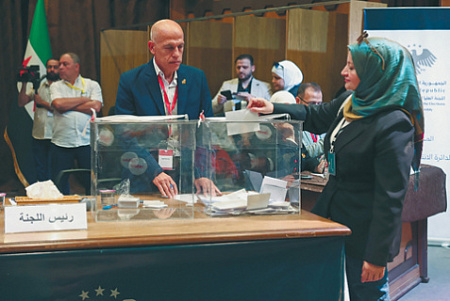
In a pivotal moment for Syria, the war-torn nation is conducting its first elections for the People’s Council, a single-chamber parliament, since the fall of Bashar al-Assad’s regime in December 2024. For interim President Ahmed ash-Sharaa, these elections represent the most significant political maneuver of his nascent leadership, offering a critical opportunity to either gain genuine legitimacy or at least the appearance of it on the international stage. However, for the future trajectory of Syria, these polls – characterized by a predetermined outcome and the deliberate exclusion of substantial, stability-crucial segments of the population – are unlikely to prove truly transformative. Many observers suggest ash-Sharaa appears to be charting a course toward building an authoritarian system, complete with all the inherent risks such a path entails.
As Sunday, October 5th, drew to a close, Syria’s Ministry of Interior reported no significant irregularities at polling stations, asserting a relatively high voter turnout and confirming that the elections would proceed despite external criticism. The West’s eventual acceptance of the results, once votes are tallied, seemed all but assured following ash-Sharaa’s visit to the United States for the UN General Assembly session in late September. Subsequent discussions with Secretary of State Marco Rubio led the latter to declare on social media that the new Syrian authorities and the U.S. share a common objective: “a stable and prosperous Syria.” Notably, the emphasis was firmly on “stability,” with no mention of “democracy.” This suggests that Western powers harbor no illusions about these Syrian elections being more than a step towards de-escalation, prioritizing the prevention of new refugee crises or resurgent terror threats over democratic ideals.
Adding to the complexity, the peculiar format of these elections has raised few international objections, highlighting the pragmatic stance of external actors. The polls are indirect, political parties are barred from participation, and public campaigning is non-existent. The electoral system itself is remarkably intricate. Ash-Sharaa’s government established a Supreme Committee last summer, which in turn appointed subcommittees in each of the country’s 62 electoral districts. By September, these subcommittees had created ‘electoral colleges’ to represent their respective districts. On October 5th, these 6,000 electors were tasked with choosing 140 of the 210 deputies for the People’s Council. The remaining 70 deputies, a significant one-third of the parliament, will be directly appointed by ash-Sharaa, a fact alone that casts serious doubt on the democratic credentials of the entire process, not to mention other critical nuances.
One such nuance is the delineation of electoral districts based on pre-war census data, entirely disregarding the millions of Syrians displaced from their homes. Furthermore, these elections, even in their current form, are notably absent in areas predominantly inhabited by Druze and Kurdish communities. The Druze-majority region of Ez-Suweida remains volatile, teetering on the brink of widespread conflict. Meanwhile, the Kurdish-controlled northeast is governed by the Syrian Democratic Forces (SDF). While ash-Sharaa had pledged to integrate SDF armed formations into the national army and their administrative bodies into national governance, this commitment, formalized in an agreement signed with SDF Commander Mazlum Abdi on March 10th, has yet to materialize. Instead, Turkey’s influence within Syria appears to have intensified, particularly in regions where its Syrian allies – and even Turkish military forces directly – have historically clashed with Kurdish factions.
Syrian authorities justify this multi-tiered electoral system by arguing that their primary objective is not to facilitate individual voting rights, but rather to ensure comprehensive representation for all diverse segments of the population within the governing bodies. Representatives from Kurdish and Druze communities are expected to be among those directly appointed by ash-Sharaa to the People’s Council. Even the electoral colleges themselves are structured around a quota system, for instance, mandating that 20% of their seats be allocated to women, aiming to project an image of inclusivity despite the lack of direct suffrage.
A particularly sensitive challenge for the new administration involves the Alawite-populated regions, the ancestral home and religious community of the deposed President Assad. March witnessed severe clashes here, officially termed a “rebellion by old regime supporters,” though many international observers described them as large-scale massacres of Alawites by Islamist groups aligned with ash-Sharaa. Since then, authorities have reportedly endeavored to de-escalate tensions in these areas. The issue of extraditing Assad is no longer a public talking point, nor does ash-Sharaa mention the withdrawal of Russian bases in Tartus and Hmeimim, which largely guarantee the security of residents in Alawite-majority provinces like Tartus and Latakia. Ash-Sharaa’s forthcoming visit to Moscow signals a clear intent by the new leadership to diversify the country’s international alliances. Nevertheless, the government has vowed to exclude functionaries of the former Assad regime from participation in the electoral colleges, navigating a delicate balance between reconciliation and consolidation of new power.
